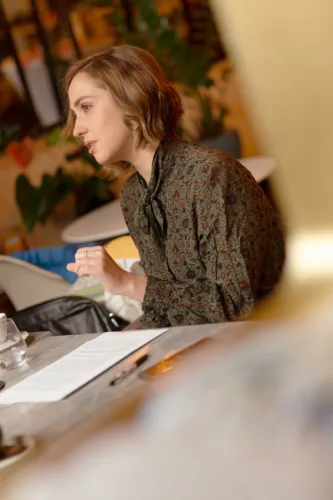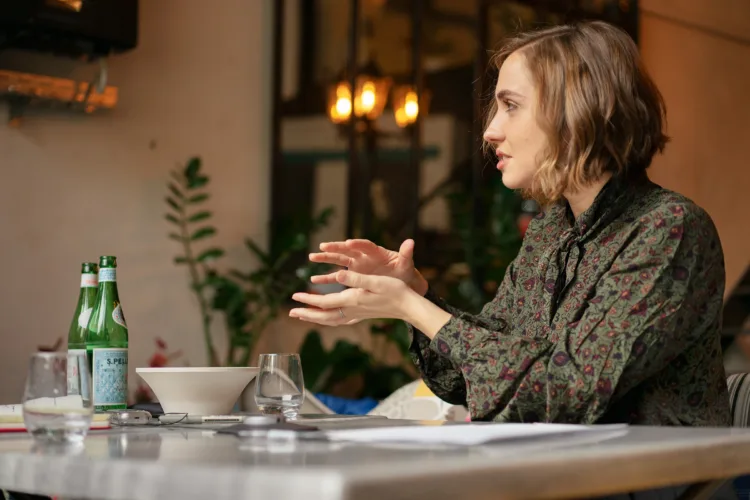
Let’s get (it) to work!
Conflicting goals and compromises on the one side, stories of success on the other: our interview with Tristanne Davis, European representative of the Sustainable Packaging Coalition in Luxemburg, provides many new and surprising findings and insights.
Is the discussion on climate change and microplastics just hysteria or do you see an urgent need for action?
You can’t be hysterical enough where climate change is concerned. Scientists agree that we have a real crisis on our hands that governments worldwide have to respond to. The situation is slightly different where microplastics are concerned: it’s great that consumers have a growing awareness of plastic waste and the fact that it doesn’t belong in the environment. However, scientific research on this topic is still in its infancy. How do microplastics affect our health? How does plastic get into the sea? How does it interact with our ecosystem? Many people feel they can specifically influence plastic pollution – perhaps because the issue is visual and emotionally provocative. Just think of the pictures of sea turtles entwined in plastic which have become synonymous with the pollution of our oceans. Compared to this, climate change is very abstract and difficult for people to feel they can control. Solving climate change means making a fundamental change in society – and this confronts us with the ultimate question of how compatible mass consumption and sustainability really are.
What role does packaging play in climate change?
Packaging certainly plays a role – but not always the one we perhaps think. In ‘Project Drawdown’, published by activist Paul Hawken in 2016, avoiding food waste is ranked number three on a list of the 80 most impactful measures to combat climate change. According to the UN’s Food and Agriculture Organization (FAO), around 30% of all food is thrown away across the globe. This amounts to 8% of our global greenhouse gas emissions. Food packaging counteracts this by protecting products during transportation and stopping them from spoiling – among all the fuss about packaging waste, we have to recognize and appreciate this. Let’s turn specifically to the different materials. Paper, for instance, can be but isn’t always a sustainable solution. As paper packaging comes from wood, it’s important to source it responsibly in a way that ensures forests are regenerated and protected, as the loss of forest also contributes to climate change. However, it’s a renewable material that, if managed well, can have positive climate benefits. On landfill sites, on the other hand, discarded paper forms methane which, like CO2, is harmful to the climate. Recycling materials and reusing them to make new products is important in the battle against climate change. This also applies to plastic, glass and aluminum. All told, the overall carbon footprint left by reused materials is normally smaller than that created by virgin materials. Processing recycled aluminum, for example, uses 95% less CO2 than making new aluminum.
This sounds as if there aren’t any easy answers.
True. The more you study the subject, the more confusing it gets. You realize that it’s often a case of conflicting goals and compromises. Is recycling of tantamount importance or the protection of the climate? In my opinion the latter should be the benchmark here.
»There are still too many brand producers who design and manufacture their packaging without thinking about recyclability.«
Senior Manager for the Sustainable Packaging Coalition (SPC)
About the person: Industrial Ecologist
Originally from Lambertville between New York City and Philadelphia, Tristanne Davis received her BA in environmental economics from Skidmore College, USA. After several years consulting for the US Environmental Protection Agency, she managed an agroforestry research program in Nicaragua. In 2016 she completed her master’s degree in environmental management at Yale University, majoring in industrial ecology, followed by an MBA program at the IE Business School in Madrid, Spain. Davis has worked for GreenBlue since 2017. The 32-year-old now supports the European members of the Sustainable Packaging Coalition in Luxembourg.
What part does packaging play in ocean pollution?
According to Ocean Conservancy, which organizes big beach clean-up campaigns every year, six out of ten objects collected are packaging. This includes, among other things, food packaging and plastic bottles, lids and bags. This illustrates how poor waste management is in many parts of the world and that there’s a lack of infrastructure for both the collection and processing of packaging waste. Accordingly, most countries among the top 20 polluters are newly industrializing countries in Asia and Africa. The USA, however, still comes in at number 20 on this list, and the EU, if seen as one country, would rank 18th. In these places, littering is a problem which comes from ignorance and laziness as well as limited access to infrastructure in some places, like in rural areas.
Good packaging, bad packaging – is there such a thing?
Absolutely. The first important criterion is whether packaging actually does its job of protecting and containing the product. If food spoils or a liquid spills because the packaging is damaged or faulty, the packaging has failed. The resources used have therefore been wasted. Packaging increasingly also has to consider sustainability, which means that it’s made with sustainably sourced materials, is optimized for the supply chain and has the ability to be reused at the end of its life. I’d refer to packaging which doesn’t meet these performance and sustainability criteria as bad.
How relevant is the packaging debate to the average consumer and how does it affect brands?
Even if the sustainability debate is of varying importance to different consumer groups, you can’t deny that it’s prompted a certain basic awareness and desire for action among all consumers. Ocean pollution is very much a public concern – not only among millennials. At the same time, NGOs such as Greenpeace are putting pressure on brands and using social media to this end, where a brand’s reputation can quickly be damaged. Many companies are developing tactics to respond to this pressure. Some treat this topic with care and intelligence; others merely indulge in greenwashing and think they can convince consumers of their good intentions by doing so.
»Brands have to provide their customers with correct information so that they can make informed decisions.«
Senior Manager for the Sustainable Packaging Coalition (SPC)
How can brand manufacturers in particular handle this issue sensibly?
It helps if brands make an effort to explain their decisions and actions to their stakeholders and commit to making continuous improvements within their sphere of influence. Each and every company has control over its own packaging portfolio and so changing packaging design to be more sustainable is one key intervention they can make. They may not control waste infrastructure directly but they can invest in funds, for instance, as one way of helping to improve the infrastructure of waste collection systems in newly industrializing countries. The reward is consumer trust and better recovery.
What needs to change in the packaging industry?
Well, companies should start with the realistic goals. There are still too many brand producers who design and manufacture their packaging without thinking about recyclability. This would be the easiest area to tackle. Compared with reuse or composting, recycling is the most established recovery system we have worldwide. People who design packaging can make good design choices that make their packaging add value to the recycling system – which in turn will keep the system alive.
How can consumers differentiate between marketing measures and real ecological commitment?
Consumers can’t be experts on all aspects of sustainability; this would be too much to expect. At the same time, brands have to provide their customers with correct information so that they can make informed decisions. There’s nothing worse than making false or ambiguous statements. What do promises such as ‘this bag is sustainable’ or ‘this cup is biodegradable’ mean exactly? Beyond ambiguous statements, there’s also greenwashing. Did you know that there are cases of brown paper bags being specifically dyed to suggest that they’re made of recycled paper when actually they’re not? If a brand fails to communicate accurate information to the purchaser of its products, then the NGOs do so through social media. However, it’s the consumer who ultimately has to form his or her own opinion. The more honest a company is in explaining its claims, the more educated consumers become.
»As long as goods are flown around the world, transport packaging will never be superfluous.«
Senior Manager for the Sustainable Packaging Coalition (SPC)
Sustainable Packaging Coalition (SPC)
The SPC is the largest project run by GreenBlue, a non-profit organization founded by William McDonough and Michael Braungart. The two authors of the bestseller ‘Cradle to Cradle: Remaking the Way We Make Things’ developed the cradle-to-cradle concept* of a consistent circular economy and coined the term ‘eco-effectiveness’. Members of the SPC include more than 400 companies from the food, beverage and chemical industries, retailers, converters, recyclers, universities and municipalities. The SPC is dedicated to discussing how packaging can become more sustainable.
Is recycling the right answer? What are the opportunities and limitations here?
Within the materials recovery loop, which includes recycling but also composting and reuse, recycling is the most sophisticated system. While this functions well for many materials throughout the world, with other materials on certain markets this doesn’t work at all. On the one hand, the criticism voiced about recycling is perfectly justified when you look at the gaps in the system. On the other, there are also a number of impressive success stories. In general, recycling works better for materials of comparatively high value. Steel, corrugated cardboard and aluminum all have high global recycling rates. However, just 9% of all plastic packaging worldwide is recycled; in the EU this is as high as 42%. Germany is the world leader with a rate of almost 56% - probably thanks to its strict waste separation regulations and deposit system for one-way bottles which is only now being trialed on other markets. Looking at it from the other side, however, worldwide we fail to reuse a massive 91% of our plastic waste. This also includes the eight million metric tons which land in our oceans every year.
Recycling is a successful model where the value of the material is recognized by the market and the infrastructure has been developed accordingly. In Brazil about 54% of PET bottles, a valuable type of plastic, are returned to the recycling loop compared to just 30% in the USA, where there are fewer collection incentives in place. Recycling is a necessary part of the solution that has been proven to work for many materials and we must work to improve it for markets and materials where it struggles to be effective. At the same time, we must also increase our efforts to reuse and compost more materials.
Which stakeholders are actually able to bring about change? Who should take the first step?
In my opinion, this obligation lies with the legislators – first and foremost. If they were to define good sustainability rules based on science and if supermarkets only sold products in packaging which conformed with these standards, consumers wouldn’t have to spend any more time deliberating and our problems would be solved.
The EU is the furthest towards creating a circular economy and poised to take further steps in this direction. Many companies now support regulations as they recognize the value of consistent regulation that gives them clarity and a sense of direction. This movement, which has originated in Europe, is having an impact the world over – including but not limited to California and Canada, where governments are keeping close tabs on what’s happening in Brussels. Global brands and big retailers also have a strong influence on the system: for them, efficient and sustainable packaging systems that work for the consumer are of growing importance.
What sensible initiatives exist that allow us to completely do away with packaging? Is this a promising approach?
Even if we do manage to successfully avoid packaging in our shopping cart on the local market, as long as goods are flown around the world and handled by many people, transport packaging will never be superfluous – from the point of view of product protection and hygiene alone. Despite this, it’s still worth noting the growing number of initiatives exploring less packaging. For instance, in some countries you can fill beans, coffee or laundry detergent into containers you bring with you to the store. Another example is Ooho, a golf ball-sized capsule of water packaged in an edible film made of seaweed and developed by a team of British designers.
What’s your vision for packaging for the future? How will we package food and beverages in 20 years to come?
The trends of today are the mainstream of tomorrow. We’ll have a great variety of packaging but also a number of different business models where packaging takes on a service role. In the food sector we’ll notice a big increase in online trade – complete with all the consequences this has. And I’m convinced that we’ll have smart systems in place which provide manufacturers with information on how we use their products – and maybe on what we do with the packaging.
* Cradle to cradle or C2C is a model upon which a consistent circular economy is based, where biological nutrients are returned to biological cycles and technical ‘nutrients’ are permanently kept in the inorganic or synthetic materials loop.







